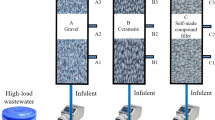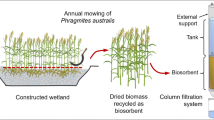Abstract
A laboratory bench-scale fixed-bed column study operated as a down-flow configuration was conducted to evaluate Sphagnum peat moss and crushed mollusk shells as natural low-cost adsorbents for the removal of heavy metals from aerated and unaerated synthetic landfill leachate. Columns were packed with 15 cm of prepared peat moss, or 15 cm adsorbent mixtures made up of peat moss and crushed mollusk shells (4.0–4.75 mm) from Lake Ontario at different bed depth ratios. Peat was found to have the best adsorption capacities in columns treating aerated synthetic leachate for cadmium and nickel with 78.6% and 83.8% removal efficiencies, respectively. The removal of chemical oxygen demand (COD) and total nitrogen from the synthetic leachate was also monitored to evaluate the potential effects of biological activity on heavy metal adsorption. Columns receiving unaerated raw synthetic leachates did not show any significant removal of COD and total nitrogen, whereas some reduction in COD and total nitrogen was noted in the columns treating aerated synthetic landfill leachate. The results suggested that biological activity and biofilm growth could positively contribute to heavy metal retention within the fixed-media biosorption columns.
Similar content being viewed by others
References
Baun DL, Christensen TH (2003) Speciation of heavy metals in landfill leachate: a review. Waste Manag Res 22:2–23
Papageorgiou SK, Katsaros FK, Kouvelos EP, Nolan JW, Herve LD, Kanellopoulos NK (2006) Heavy metal sorption by calcium alginate beads from Laminaria digitata. J Hazard Mater B137: 1765–1772
Çeçen F, Gürsoy G (2001) Biosorption of heavy metals from landfill leachate onto activated sludge. J Environ Sci Health A36: 987–998
Enzminger JD, Robertson D, Ahlert RC, Kosson DS (1987) Treatment of landfill leachates. J Hazard Mater 14:83–101
Aziz HA, Yusoff MS, Adlan MN, Adnan NH, Alias S (2004) Physico-chemical removal of iron from semi-aerobic landfill leachate by limestone filter. Waste Manag 24:353–358
Kargi F, Pamukoglu MY (2004) Adsorbent supplemented biological treatment of pre-treated landfill leachate by fed-batch operation. Bioresour Technol 94:285–291
Uygur A, Kargi F (2004) Biological nutrient removal from pretreatment landfill leachate in a sequencing batch reactor. J Environ Manag 71:9–14
Kietlińska A, Renman G (2005) An evaluation of reactive filter media for treating landfill leachate. Chemosphere 61:933–940
Kurniawan TA, Lo W, Chan GY (2006) Physico-chemical treatments for removal of recalcitrant contaminants from landfill leachate. J Hazard Mater B 129:80–100
Aly AS, Jeon BD, Park YH (1997) Preparation and evaluation of the chitin derivatives for wastewater treatments. Journal of Applied Polymer Sicence 65(10):1939–1946
Benguella B, Benaissa H (2002) Cadmium removal from aqueous solutions by chitin: kinetic and equilibrium studies. Water Res 36:2436–2474
Rae IB, Gibb SW (2003) Removal of metals from aqueous solutions using natural chitinous materials. Water Sci Technol 47:189–196
Zhou D, Zhang L, Zhou J, Guo S (2004) Cellulose/chitin beads for adsorption of heavy metals in aqueous solution. Water Res 38:2643–2650
Saiano F, Ciofalo M, Cacciola S, Ramirez S (2005) Metal ion adsorption by Phomopsis sp. Biomaterial in laboratory experiments and real wastewater treatments. Water Res 39:2273–2280
Baran A, Bicak E, Baysal S, Onal S (2006) Comparative studies on the adsorption of Cr (VI) ions onto various sorbents. Bioresour Technol 98:661–665
Cochrane EL, Lu S, Gibb SW, Villaescusa I (2006) A comparison of low-cost biosorbents and commercial sorbents for the removal of copper from aqueous media. J Hazard Mater B 137:198–206
Lee M, Hong K, Kajiuchi T, Yang J (2004) Determination of the efficiency and removal mechanism of cobalt by crab shell particles. J Chem Technol Biotechnol 79:1388–1394
McLellan JK, Rock CA (1988) Pretreating landfill leachate with peat to remove metals. Water Air Soil Poll 37:203–215
Allen SJ, Whitten LJ, Murray M, Duggan O (1997) The adsorption of pollutants by peat, lignite and activated chars. J Chem Technol Biotechnol 68:442–452
Ringqvist L, Holmgren A, Öborn I (2001) Poorly humified peat as an adsorbent for metals in wastewater. Water Res 36:2394–2404
Heavy M (2003) Low-cost treatment of landfill leachate using peat. Waste Manag 23:447–454
Champagne P, Van Geel P, Parker W (2005) Development of a combined passive system for the reduction of metals and sulphate in acid mine drainage. Mine Water Environ 24:124–133
Qin F, Wen B, Shan X, Xie Y, Liu T, Zhang S, Khan SU (2006) Mechanisms of competitive adsorption of Pb, Cu, and Cd on peat. Environ Poll 144:669–680
Champagne P, Van Geel P, Parker W (2008) Impact of constituent loading and temperature on the mitigation of AMD in peat biofilters. Mine Water Environ 27(4):225–240
Ulmanu M, Maranon E, Fernandez Y, Casterillon L, Anger I, Dumitriu D (2003) Removal of copper and cadmium ions from diluted aqueous solutions by low-cost and waste material adsorbents. Water Air Soil Poll 142:357–373
Choi SB, Yun Y (2006) Biosorption of cadmium by various types of dried sludge: an equilibrium study and investigation of mechanisms. J Hazard Mater B138:378–383
Cetin S, Pehlivan E (2007) The use of fly ash as a low-cost, environmentally friendly alternative to activated carbon for the removal of heavy metals from aqueous solutions. Colloid Surface A 298:83–87
Brown PA, Gill SA, Allen SJ (2000) Review paper: metal removal from wastewater using peat. Water Res 34:3907–3916
Hrapovic L, Rowe RK (2002) Intrinsic degradation of volatile fatty acids in laboratory-compacted clayey soil. J Contam Hydrol 58:221–242
VanGulck JF, Rowe RK (2004) Evolution of clog formation with time in columns permeated with synthetic landfill leachate. J Contam Hydrol 75:115–139
Li C, Champagne P (2009) Comparative fixed-bed column study on the adsorption of cadmium (II) and nickel (II) ions in binary metal aqueous solutions using peat and crushed mollusk shells. J Environ Sci Technol (Submitted January 10, 2009; Ref. ES-2008-03641Q)
Chenxi L, Champagne P (2009) Fxied-bed column study for the adsorption of cadmium (II) and nickel (II) ions in aqueous solution using peat and mollusk shells. Journal of Hazardous Material 171: 872–878
Kylefors K, Ecke H, Lagerkvist A (2003) Accuracy of COD test for landfill leachates. Water Air Soil Poll 146:153–169
Morelli J (1992) Leachate recirculation: design and operation considerations. MSW Manage 2(3):26–36
Couillard D (1994) Review: the use of peat in wastewater treatment. Water Resour 28:1261–1274
Champagne P, Khalekuzzaman M (2006) A sequential aerated peat biofilter system for the treatment of landfill leachate. In: Proceedings of the Second International Conference on Evolution, Monitoring, Simulation, Management and Remediation of the Geological Environment and Landscape. IASTED June 6–8, Rhodes, Greece, pp 125–134
Liehr SK, Chen H, Lin S (1994) Metals removal by algal biofilms. Water Sci Technol 30:59–68
Champagne P (2001) A combined passive system for the treatment of acid mine drainage. Thesis, Department of Civil and Environmental Engineering, Carleton University, Ottawa
Scott JA, Karanjkar AM, Rowe DL (1995) Biofilm-covered granular activated carbon for decontamination of streams containing heavy metals and organic chemicals. Min Eng 8:221–230
Cloirec PL, Andres Y, Faur-Brasquet C, Gerente C (2003) Engineering biofilms for heavy metal ion removal. Environ Sci Bio-Technol 2:177–192
Birch L, Baschofen R (1990) Complexing agents from microorganisms. Experientia 46:827–834
APHA. (1995) Standard Methods. 19th Edition, American Public Health Association, Washington, DC.
Author information
Authors and Affiliations
Corresponding author
Rights and permissions
About this article
Cite this article
Champagne, P., Li, C. Use of Sphagnum peat moss and crushed mollusk shells in fixed-bed columns for the treatment of synthetic landfill leachate. J Mater Cycles Waste Manag 11, 339–347 (2009). https://doi.org/10.1007/s10163-009-0262-4
Received:
Accepted:
Published:
Issue Date:
DOI: https://doi.org/10.1007/s10163-009-0262-4




